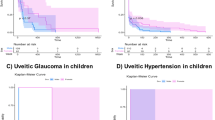Abstract
To identify clinical features and prognostic factors in patients with Fuchs’ uveitis (FU). All patients diagnosed with FU at King Khaled Eye Specialist Hospital between 1983 and 2005 were reviewed. Data collected included age, gender, initial and final visual acuities, clinical findings at presentation and during follow-up visits, interval between onset of symptoms and presentation to our institute, ocular complications, details of surgical procedures, and duration of follow-up. One hundred and sixty-six patients (174 eyes) were identified. There were 92 (55.4%) males and 74 (44.6%) females with a mean age of 35.2 ± 10.5 years (range 10–70 years). The mean follow-up period was 57.3 ± 96.7 months (range 1–146 months). The most common presenting symptom was decreased vision (79.9%). Characteristic keratic precipitates (90.2%), diffuse iris stromal atrophy (100%), heterochronmia (13.9%), iris nodules (13.8%), vitreous opacity (50%) (not including sparse vitreous infiltration), cataract (85.6%) and glaucoma (27.6%) were the major clinical findings. The following factors were significantly associated with final visual acuity of 20/40 or better by univariate analysis: shorter interval between onset of symptoms and presentation (p = 0.0087), good initial visual acuity of 20/40 or better (p = 0.0356), absence of glaucoma at presentation (p = 0.0264), no glaucoma surgery (p = 0.0035), and absence of glaucoma and cataract at last visit (p = 0.0126). Logistic regression analysis revealed that final visual acuity of 20/40 or better was negatively correlated with a longer interval between onset of symptoms and presentation (odds ratio (OD) 0.201; 95% confidence interval (CI) 0.0734–0.548), and glaucoma surgical intervention (OD 0.247; 95% CI 0.0796–0.766). Initial visual acuity of 20/40 or better was positively associated with final visual acuity of 20/40 or better (OD 3.34; 95% CI 1.13–9.90). A shorter interval between onset of symptoms and presentation to our institute, better initial visual acuity, and no glaucoma surgery were significantly associated with better final visual acuity.





Similar content being viewed by others
References
Kimura SJ (1978) Fuchs’ syndrome of heterochromic cyclitis in brown-eyed patients. Trans Am Ophthalmol Soc 76:76–89
Liesegang TJ (1982) Clinical features and prognosis in Fuchs’ uveitis syndrome. Arch Ophthalmol 100:1622–1626
Franceschetti A (1995) Heterochromic cyclitis (Fuchs’ syndrome). Am J Ophthalmol 39:50–58
Jones NP (1993) Heterochromic uveitis: an update. Surv Ophthalmol 37:253–272
La Hey E, Baarsma GS, De Vries J, Kijlstra A (1991) Clinical analysis of Fuchs’ heterochromic cyclitis. Doc Ophthalmol 78:225–235
La Hey E, de Jong PT, Kijlstra A (1994) Fuchs’ heterochromic cyclitis: review of the literature on the pathogenic mechanisms. Br J Ophthalmol 78:307–312
Quentin CD, Reiber H (2004) Fuchs heterochromic cyclitis: rubella virus antibodies and genome in aqueous humor. Am J Ophthalmol 138:46–54
de Groot-Mijnes JD, de Visser L, Rothova A, Schuller M, van Loon AM, Weersink AJ (2006) Rubella virus is associated with Fuchs heterochromic iridocyclitis. Am J Ophthalmol 141:212–214
de Visser L, Braakenburg A, Rothova A, de Boer JH (2008) Rubella virus-associated uveitis: clinical manifestations and visual prognosis. Am J Ophthalmol 146:292–297
Ruokonen PC, Metzner S, Ucer A, Torun N, Hofmann J, Pleyer U (2010) Intraocular antibody synthesis against rubella virus and other microorganisms in Fuchs’ heterochromic cyclitis. Graefes Arch Clin Exp Ophthalmol 248:565–571
Jones NP (1991) Fuchs’ heterochromic uveitis: a reappraisal of the clinical spectrum. Eye 5:649–661
Arellanes-Garcīa L, del Carmen Preciado-Delgadillo M, Recillas-Gispert C (2002) Fuchs’ heterochromic iridocyclitis: clinical manifestations in dark-eyed Mexican patients. Ocul Immunol Inflamm 10:125–131
Yang P, Fang W, Jin H, Li B, Chen X, Kijlstra A (2006) Clinical features of Chinese patients with Fuchs’ syndrome. Ophthalmology 113:473–480
Al-Rajhi A, Tabbara K (1997) Fuchs’ heterochromic iridocyclitis. Saudi J Ophthalmol 11:107–113
Dernouchamps JP (1984) Fuchs’ heterochromic cyclitis: an IUSG study on 550 cases. In: Saari KM (ed) Uveitis update. Elsevier, Amsterdam, pp 129–135
Tabbut BR, Tessler HH, Williams D (1988) Fuchs’ heterochromic iridocyclitis in blacks. Arch Ophthalmol 106:1688–1690
Fearnley IR, Rosenthal AR (1995) Fuchs’ heterochromic iridocyclitis revisited. Acta Ophthalmol Scand 73:166–170
Velilla S, Dios E, Herreras JM, Calonge M (2001) Fuchs’ heterochromic iridocyclitis: a review of 26 cases. Ocul Immunol Inflamm 9:169–175
Bouchenaki N, Herbort CP (2009) Fuchs’ uveitis: failure to associate vitritis and disc hyperfluorescence with the disease is the major factor for misdiagnosis and diagnosis delay. Middle East Afr J Ophthalmol 16:239–244
Jones NP (1991) Glaucoma in Fuchs’ heterochromic uveitis: aetiology, management and outcome. Eye 5:662–667
La Hey E, de Vries J, Laugerhorst CT, Baarsma GS, Kijlstra A (1993) Treatment and prognosis of secondary glaucoma in Fuchs’ heterochromic iridocyclitis. Am J Ophthalmol 116:327–340
Acknowledgements
The authors thank Mr Dustan Kangave, MSc for statistical assistance and Ms Connie B. Unisa-Marfil for secretarial work.
Author information
Authors and Affiliations
Corresponding author
Rights and permissions
About this article
Cite this article
Al-Mansour, Y.S., Al-Rajhi, A.A., Al-Dhibi, H. et al. Clinical features and prognostic factors in Fuchs’ uveitis. Int Ophthalmol 30, 501–509 (2010). https://doi.org/10.1007/s10792-010-9379-7
Received:
Accepted:
Published:
Issue Date:
DOI: https://doi.org/10.1007/s10792-010-9379-7




